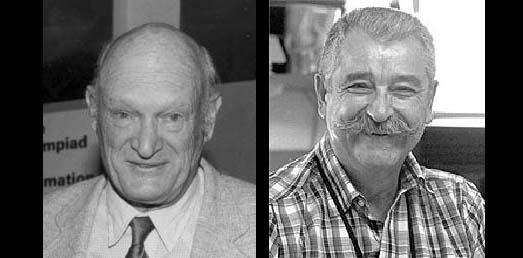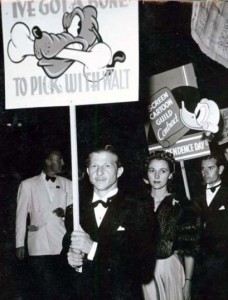Producer-director José Cuauhtémoc Meléndez and animator William Littlejohn are the subject of this March 18, 1998 interview by Martha and Sol Sigall done for the Motion Picture Screen Cartoonists, IATSE Local 839 (today’s Animation Guild). Though they do share some anecdotes about the Golden Age of Animation, much of their conversation revolves around their involvement with the Screen Cartoonists Guild (SCG), including the 1941 Disney strike. I suspect much of what they say about this might not be clear to many, so allow me to provide some context.

Bill Littlejohn (left) and Bill Melendez (right)
First off, during the Disney strike, Melendez was an assistant animator at Disney making $27.50 a week and did “sanitation” duty in the union camp across the street from the studio. (He shared his responsibilities with Reg Massie and Vip Partch.) Littlejohn, for his part, was an MGM animator and Guild President. The two link the strike to a chain of events that resulted in the Guild losing a bitter jurisdictional fight with Local 839 in 1951. By that time, Melendez was SCG President and Littlejohn its Business Representative.
During the mid-1930s, after the International Alliance of Theatrical and Stage Employees lost a dispute with rival craft unions, the IA regained power after it had been taken over by the Chicago mob (Al Capone’s old gang). George Browne became the IA’s International President while Willie Bioff took charge of its Hollywood locals. The IA and the major studios then colluded in a mutually beneficial relationship to maintain labor peace.
The corruption at the heart of the deal was the nominal reason that Walt Disney urged Art Babbitt to form the Federation of Screen Cartoonists, lest the gangster-controlled IA organize the studio’s artists. When Babbitt realized the Federation was a company union, he joined the Guild and became the leader of its Disney unit. Bioff’s last stand was his failed attempt to settle the strike on Disney’s behalf. This and Bioff and Browne’s subsequent convictions for extortion seemed to end the mob’s control over the IA; however, Melendez and Littlejohn obviously didn’t think it really ended corruption in it.I should also note that the Guild had become a viable organization when it got a charter in 1940 from the studio local of the Painters and Paperhangers union headed by Herb Sorrell. As a result, Walt Disney did not take kindly to Sorrell, who he accused of being a Communist. When Sorrell was kicked out of Hollywood during the postwar labor wars, the Guild under Melendez’s and Littlejohn’s leadership broke from the Painters and became an independent union. This provided an opening for the IA who, with backing from Disney, set up today’s Animation Guild and won a bitterly fought election to represent the major cartoon studios. The IA in Los Angeles was then under the leadership of Roy Brewer, who was also running the infamous Hollywood Blacklist. The Screen Cartoonists Guild continued to soldier on until it eventually was taken over by a Teamsters local. (Among the studios it represented, was Bill Melendez Productions.)
I should note also note that Melendez’s strong assertion that Walt Disney was anti-Semitic was a view he freely espoused, including to me on several occasions. However, like most people who make this accusation, he never really offered any proof.
Finally, Littlejohn’s story of how he got into animation unintentionally unveils a tantalizing bit of little-known history of women in animation. He got his first job through an unnamed aunt, who was doing timing and camerawork at Van Beuren. (I must admit I didn’t really pick up on the importance of this when I first interviewed Littlejohn a number of years earlier.) The fact it was not uncommon for women to do this sort of work in the early days of animation, is something that really needs to be explored in more depth.
Here’s the interview. You may need to turn up the volume for some parts.



 Harvey Deneroff is an independent film and animation historian based in Los Angeles specializing in labor history. The founder and past president of the Society for Animation Studies, he was also the first editor of Animation Magazine and AWN.com. Harvey also blogs at deneroff.com/blog.
Harvey Deneroff is an independent film and animation historian based in Los Angeles specializing in labor history. The founder and past president of the Society for Animation Studies, he was also the first editor of Animation Magazine and AWN.com. Harvey also blogs at deneroff.com/blog.




































































Nice interview! It’s a dream to see these two interviewed, especially as a fan of Peanuts…….
Agreed! Very interesting tidbits concerning Schulz and Peanuts beginning at the 43 min 7 sec mark:
https://www.youtube.com/watch?v=2sCI1WSWvHc#t=43m07s
My favorite part is Schulz commenting on the animation drawings and how they went “off-model” for the inbetweens.
What a shame these two greats of animation history are reminiscing when you can barely hear them through a cheap condenser mike.
I turned the audio all the way up, and could hear most everything. Thanks Harvey, for putting this up. I love to hear the voices of old friends like Martha and Sol, Bill Littlejohn and JC Melendez. I loved the stories about Milt Gross, hearing Bill Melendez call Bill Hanna and Joe Barbera, cheap sons o’ bitches, how John Sutherland never stopped talking once he got started, etc. It was also quite a story that Bill Melendez told about Jerry and Ted Woolery refusing to read track for him when he was teaching animation at USC, which led to Melendez leaving Ade Woolery and Playhouse Pictures. I always thought that the Peanuts contract to make TV specials had something to do with Melendez leaving Playhouse and setting up his own studio. In the end, it really doesn’t matter how true or false these stories are, the mere fact that they exist and we can hear these great animators tell the tales is the pleasant miracle.